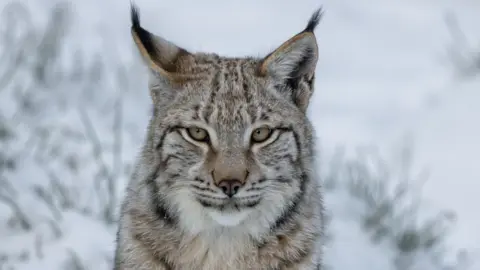Swinney rules out return of lynx to Scotland
 Getty Images
Getty ImagesFirst Minister John Swinney has ruled out the legal reintroduction of lynx into the wild in Scotland.
His comments follow concerns about the illegal release of four lynx in the Cairngorms last month.
Campaigners have been working on plans for the controlled reintroduction of the cats to benefit rural biodiversity but farmers have raised concerns about the impact they would have on livestock.
At the NFU Scotland conference, Mr Swinney said the reintroduction of lynx, or any other carnivorous species, would not take place under his government.
The wild cats were once native to Britain but were driven to extinction 500 to 1,000 years ago through habitat loss and hunting.
Swinney told the conference: "Ministers are acutely aware of the concerns many of you have about the introduction of new species.
"Let me be very clear, the recent illegal release of four lynx was both reckless and posed a serious risk to the welfare of those animals released.
"My government will not be reintroducing lynx, or indeed any other large carnivorous species in Scotland."
He said the introduction of other species such as white-tailed sea eagles had led to "unintended consequences".
The first minister said it was important to set out the policy position of his government on the lynx issue.
"We've got to wrestle with various issues of balance within the rural community in Scotland," he said.
"We've got to balance the action we've got to take on climate. We've got to balance the action to ensure we've got an adequate supply of food production.
"We've got to make sure that we've got viable investments within our rural economy - and I don't see the reintroduction of the lynx being compatible with that balanced agenda that the government's got to take forward."
One farmer pointed out that reintroduced beavers had caused damage worth hundreds of thousands of pounds.
Swinney said there needed to be a "considered discussion" around reintroducing species, pointing out that the beaver population in Perthshire was now "formidably more comprehensive than it was at the beginning".
He said he had witnessed "very directly and dramatically" the impact of beavers on flood prevention measures in his own constituency.
Some wildlife groups are keen to see lynx one day roam free under legal reintroductions.
Peter Cairns of the Lynx to Scotland Project, a three-charity partnership working to restore them to the Scottish Highlands, said there was no reason why there could not be a "carefully-managed" reintroduction.
He said: "John Swinney's government was brave enough to declare a climate emergency when others were sitting on the fence.
"The climate and biodiversity crises are inextricably linked, so we should be clear about the choice we face: we either support the sometimes uneasy business of co-existence with wild animals, like lynx, or we endorse their absolute exclusion."
He added that consistent polling pointed to "more Scots than ever before" supporting a carefully-managed lynx reintroduction.
"If countries like Uganda or Sri Lanka, with much higher human populations and lower GDPs, can somehow manage to co-exist with elephants, leopards or lions, it is hard to argue that Scotland can't accommodate a medium-sized cat like the lynx," he said.
Lynx on the loose
Steve Micklewright, chief executive of Trees for Life, said: "Scotland is one of a handful of European countries still lacking a large terrestrial mammal predator.
"If we are serious about tackling the nature and climate emergencies, we need lynx back."
In December, police issued a warning after two Eurasian lynx were spotted on the loose in the Cairngorms.
They were later captured in traps near Kingussie. However, barely 24 hours later, two more escaped cats were on the loose in the area.
One of those lynx died after they were captured, and the Royal Zoological Society of Scotland later said all the cats were showing signs of starvation.
The other three lynx are being cared for at Edinburgh Zoo.
It is still not known where the big cats came from.
A licence is required under the Dangerous Animals Act to keep lynx.
Highland Council said no premises in the area had applied for, or were operating under, a Dangerous Wild Animal (DWA) licence - suggesting they had come from somewhere else.
Scotland's nature agency NatureScot also said it had not granted any licences for the reintroduction of lynx.
